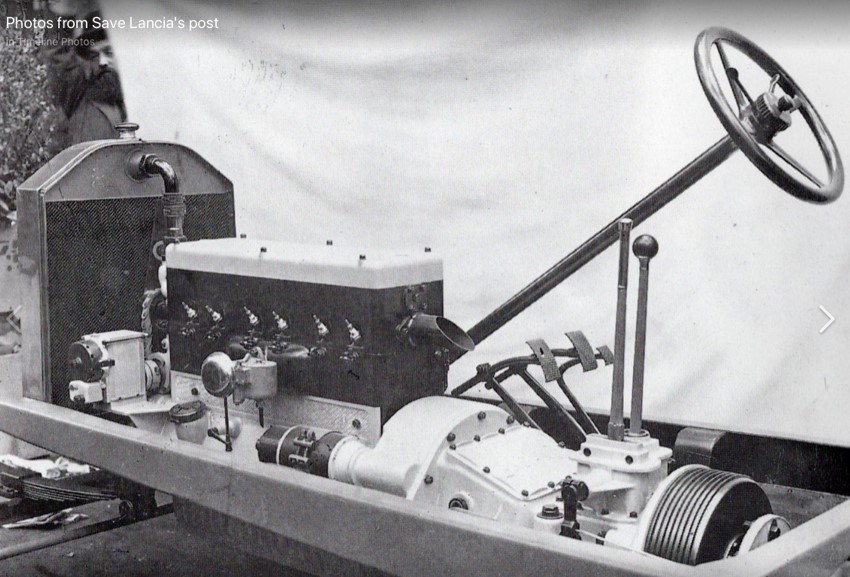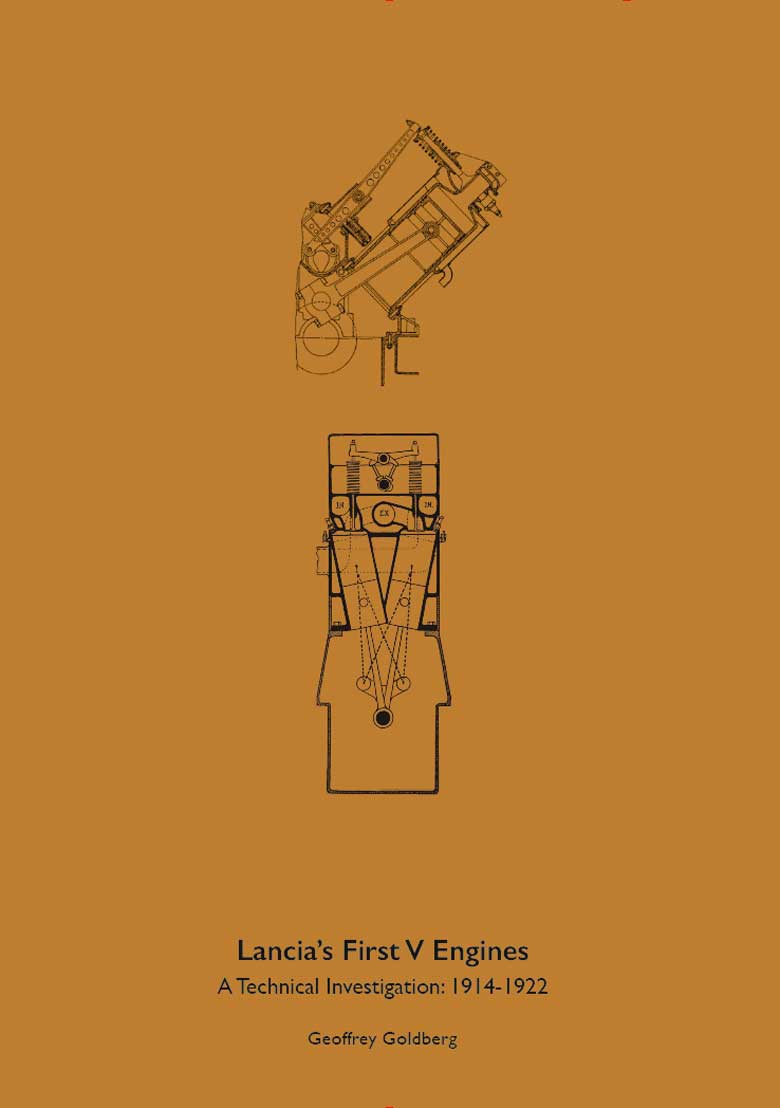A review by Pete Vack
The technical development and history of automobile and aero engines from Fiat, Alfa Romeo and Ferrari have been thoroughly examined. There is little, if anything, left to know, research or publish.
Not so with Lancia. But now, Geoffrey Goldberg, Lancia historian, author and architect from Chicago, helps fill the gaps with this technical investigation of the first Lancia V engines.
Lancia’s narrow-angle Vs
From 1922 to 1976, Lancia largely used a series of unique narrow angle V4 and V8 engines in their cars. And while the later 60º V6 and the Flavia flat 4 of 1960 were not of this family, all of their other cars for fifty years used these narrow V engines, a rather unconventional focus for such a prestigious car manufacturer.
Narrow angle V configurations, roughly defined as a V of less than 30 degrees overall, were not new; Goldberg lists the Daimler V twin of 1889, the Christie V4, a 1910 design by Delahaye among others. But after WWI, Lancia would hang their hat on the unconventional narrow V.
“While other manufacturers made engines with V angles, none were as committed to the narrow V configuration as Lancia was for some fifty years,” writes Goldberg.
Since these V configurations were integral to the company’s success, Goldberg’s study is much more relevant than a first glance would warrant. With some ½ million of these engines produced, Goldberg thought to investigate how the idea of the narrow angle V came about. This research was the result of many years of investigation in the Centro Storico Fiat Archives, reviewing hundreds of original drawings, as well as visiting other archives.
Aero engines for the war effort
Goldberg has uncovered the little-known history of the development of these V engines, starting with the design of aero engines during WWI. Although never in production, Goldberg found three distinct aero V engines created by Lancia engineers, projects that eventually led to an automotive 30 degree V12 in 1919 and their first narrow V production engine, a V8 in the Trikappa of 1922. He covers many engines that exist only in sketches, but looks in detail at the development path to understand their thinking as it evolved.
Goldberg outlined his key findings thusly:
*the evolution of Lancia’s three aero engines, a V8 and two V12s, with a surprising test report in the US of one of the aero engines.
*the detailed development and investigation into new solutions for crankshaft design for their V engines
*finding previously unknown prototype narrow V engines from 1920 to 1922
*and early studies and work on the Lambda V4 prior to production
The early work on V angles starts with the aero engines (which to be clear, were not narrow Vs), trying to put more engine displacement in a fixed width of the planes. The three Lancia aero engines all featured individual water cooled cylinders on an aluminum crankcase, horizontal valves operated by rocker arms, driven by a single camshaft in the center of the V. The V angles were 90 degrees, 50 degrees and 53 degrees. The first one found was a V8, the Tipo 3, followed by detailed investigations into the already known Tipos 4 and 5, both V12s.
Found in the Detroit Public Library was a detailed test report on the Tipo 4 aircraft engine, which found its way to the US Government McCook Airfield in Ohio for testing to augment learning about the worldwide aero industry. The tests showed the Lancia engine suffered from a lack of rigidity, causing a number of other issues. Structural stiffness was an issue with many early engines, but most damaging with aero engines for obvious reasons. Goldberg includes comparison and details on other aero engine designs including Daimler Benz, Rolls Royce, Hispano Suiza and others to give context to Lancia’s early work.
The path to the narrow angle V
After the war, their focus changed to narrow angle Vs with increased stiffness good for durability. How did the aero engine research lead to a narrow angle V engine? Goldberg explains:
– Up to 1922, all their auto engines were in-line 4s. There is no indication of anything (other than an early odd in-line 6) of different configs. None whatsoever. So the narrow V or more generally, the interest in alternative engine configurations had to come from somewhere – it’s original work, not just copied from someone else. We propose the work begins with V aero engines, fiddling with the angles for different versions. With this begins crankshaft research (1915, 1917 patents, different crankshaft configurations) and leads to thinking about V angles and engine layout more broadly.
– After the war, their first return back to auto engines is a 30º V12, a composite reworking of their earlier in-line 4 cylinder engines with side valves into a V12. Not a great design, but an important linkage.
– They then move to the 1919 narrow 13º V12, which sets off the new trend through several prototypes to production engines.

The 13 degree V12 prototype was so compact it appeared as a straight six. Alas, it was not put into production.
In another chapter, he sheds a bit of light on the Lancia engineers who signed off on the various drawings, many of them presented in the book. He notes that the same designers, primarily Frassati and Cantarini, worked on both the aero engines and the early automotive V12s and V8s. Included is an appendix listing of the several hundred drawings reviewed, with dates and who drew what.

Goldberg found that the major car magazines featuring the 1919 Lancia Paris show car had the V angle wrong at 22 degrees vs 13 degrees. The narrow angle V12 was “the grandfather for all Lancia narrow angle V engines that would follow for the next fifty years.”
Goldberg studiously corrects misunderstandings about the V12 with access to the original design drawings, and is able to unravel some of the early development work on the Lambda. With a close look at any published writings from the time, he says, “We don’t know the full story, maybe only half of it. They did not share their inner workings, but looking in detail at the changes and evolution, its possible to see their path forward.”

On the cover is a drawing of the 13 degree V12, bottom, and at the top, the valve train of the first V engine for aircraft use.
Typically with Goldberg’s work, there is detail and thoroughness, although the book remains quite readable with illustrations and diagrams. We needn’t need to say that Goldberg’s latest essay complete with notes and bibliography, is another essential addition to serious Lancia histories and libraries, but also for those interested in alternative pathways in engine design.
Lancia’s First V Engines
A Technical Investigation, 1914-1922
By Geoffrey Goldberg
Privately published.
Soft cover, 197 pages
It can be found at these booksellers:
US Dealer:
Autobooks-Aerobooks, Tina Van Curen
2900 W. Magnolia Blvd.
Burbank, CA 91505
818 845-0707
European dealers:
– Gilena (Brescia, Italy)
– Ben Horton’s Books and David Thomas Motor Books (England),
– Frenky (Holland).
NOTE: You can order any of Geoff Goldberg’s books directly as well, by contacting the author at gg@g2a2.com.
He will provide the method best for you. The book is listed at $50, but he will apply the VeloceToday discount.
Other book reviews on books by Geoffrey Goldberg:

Glad to see Geoff continuing to explore and explain Lancia engineering. When Geoff drove his Lancia B20 on the Colorado Grand, we discussed the book he was writing about little-known Lancia engineer de Virgilio, who developed the first practical V4 engine. He was looking for a quality publisher, so I pointed him toward David Bull, who agreed to publish it. Since I was copy-editing for David back then (around 2010), I worked on it, which sparked my interest in Lancia to the point that a 1973 Fulvia 1600HF now graces my garage!
How timely. I met a fellow who just bought a Fulvia Zagato and after seeing I knew about the car tossed me the keys and asked me to take it for a spin. I wish every day were like these!
It was fun starting it and driving on the brick roads of Savannah. I was trying to sense the V4 and get a feel for it. It was my first time driving it. I didn’t expect anything and was pleasantly surprised knowing how it was laid out. It didn’t vibrate as much as a straight-4 and was pretty smooth.
It’s bonkers to see what FIAT turned Lancia into and now trying to sell it off. I feel I’m seeing the 2009 GM, Ford, and Chrysler saga all over again. I hope the brand finds the right company to bring back its laurel leaves. That Zagato was fun to drive, even on Savannah’s won’t back streets.